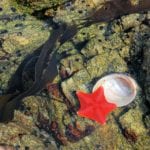Can you imagine the reaction of a father, told by his pre-teen son, that he couldn’t bust a watermelon? I was that son and still remember the anger in his face when I told him that unbelievable lie, as it seemed to him at the time.
My father loved farming and, as a result, was very successful in growing a variety of crops for market. But among the many products that he grew, one was his clear favorite. Watermelons! And not just watermelons, but huge watermelons that he took great pride in not only growing but showing off to friends and customers who came to our farm.
Those melons were all direct decedents of melons that he had grown for many years. Let me explain. Although he annually purchased seed for most of the fruits and vegetables that he grew, they did not include watermelons. These were grown from the seeds that he saved, year after year, to produce the next crop. It takes a lot of seed to plant several acres of watermelons, but he had a method of insuring that there was an adequate amount for this purpose.
When the crop ripened, the largest and most perfect specimens were marked, not for selling, but rather stored for future use. No one was allowed to touch them, much less eat one. That was fully understood by the entire family. I clearly remember how he would pick a future day, almost always a Sunday afternoon, and begin to tell family, friends and neighbors that there was going to be a “watermelon cutting” and be sure to stop by our house. Looking back, I now understand that this was more than free watermelon, but a social event for the community.
I remember how, throughout the afternoon, there was a stream of families constantly stopping by our house to eat watermelon. I also recall how this shy and unassuming man was always the one standing at a table underneath a shade tree in the front yard, huge butcher knife in hand, slicing thick wedges of blood red watermelons and proudly handing slices to outstretched hands. Now remember, the subtle purpose of this gathering was to accumulate seed for next year’s crop; however, this was never mentioned directly. Instead, he had placed large washtubs around the area and casually mentioned, “Any rinds or leftover fruit should be thrown into the tubs for the hogs.” Indeed, that was true, for we always had hogs and they loved watermelons and would eat every single bite that they were fed.
Eventually the gathering began to thin in the afternoon, as friends took their leave and started for home. There was always the hearty congratulations and thanks for the delicious watermelon feast, frequently high praise for dad on not only the taste but the huge size of the melons. The usual response to this was a deeper blushing of his already ruddy complexion, for he always seemed uncertain of how to respond to a compliment. When the last of the visitors had left, then the real work began.
The large slices of rind, with any residual ripe fruit still attached, were carefully separated and any remaining seeds were first removed and dropped back into the container. These rinds were, as my father had promised, carried away and fed to the eagerly waiting hogs. As the large residue was removed, what remained in the tubs were pieces of discarded watermelon fruit, juice and seed. Any pieces of fruit that contained seeds had the seeds removed before the remaining flesh also fed to the hogs. Removing the seeds was easy; merely squeeze the price of fruit in your hand and out popped the seeds into the tub below.
Even when I was a young boy, I always found it interesting to watch people eat watermelon, especially what they did with the seeds. People seem averse to the thought of eating seeds, and maybe that was due, in part, to the fact that the seeds of the variety of melons my father grew were small coal-black dots in the flesh of the red melon. As the fruit was consumed, those seeds were also thrown into the tubs as waste along with the green rinds. So, as the green rinds were removed from the tubs, there remained a large quantity of red watermelon juice on which floated a raft of black seeds.
Perhaps I should put the quantity into context for the reader. The largest melons were reserved and served at the “watermelon cutting.” They probably averaged 40-50 pounds each, huge circumference and filled with literally hundreds of seeds. These were the largest and most perfect specimens of the entire crop. It would not be unusual for up to 25 or more of these melons to be served throughout the afternoon.
But let me digress for a few moments for a personal item. When I was a small boy, one of my uncles told me confidentially, “If you swallow one of those watermelon seeds, a vine will grow out of your mouth.” It literally scared me to death and, as you might imagine, I was judicious in making sure that every seed was removed before I ate the fruit. It must have been a couple of years later that I learned he was kidding me and no such thing would happen. Upon learning that, never again did I remove a seed. I ate them, along with the melon. Now into my mid 70’s, I must tell you that the same thing is true. I always eat the seeds and never bother to remove them. So far, so good, no vines have yet been detected by my dentist or physician!
To make a long story short, the process of saving these seed for future use was labor intensive and took long hours as the individual seeds needed to be thoroughly cleaned so that none of the sticky, sugary sediment from the fruit remained. Thus, it took multiple washings and hand sorting for clean seed. My dad seemed to take pleasure in this task, for he was a patient man and no doubt was thinking about next year’s crop as he carefully cleaned and sorted. Once they were perfectly clean, they needed to dry thoroughly. This was another daunting task.
He would spread the seed on a frame of screen wire to that air circulating on both sides. As they dried, periodically they had to be stirred and returned to a single layer. If the seeds were not perfectly dried, they would mold before the next planting season. But remember, we lived on a farm. Birds were certainly a threat, for they loved finding a large quantity of drying watermelon seeds there for the taking! Rodents as well, and mice are small and very difficult to prevent from joining the feast.
So, after a period, perhaps a week, whatever seed remained were the source for next year’s fruit, producing the direct descendants for the next crop of watermelons. These were sealed in glass quart jars and carefully stored away for the next several months.
But this process primarily applied to his watermelons and not the other fruits and vegetables that he grew. These seeds were purchased by mail order from a catalogue. I can still remember, as a boy, him sitting in his easy chair during the long winter nights and pouring over his Burpee Seed Catalogue as he decided which crops he would plant the following spring, what new variety he would try. I just looked on the Internet and, much to my surprise, I found the Burpee website! It’s still around.
One hot July day, he told me, “check on those icebox melons. Bust one to see if they are ripe.” He had planted a couple of dozen hills of the small watermelons in one corner of a field. The small melons, about the size of a honeydew melon, were within sight of the house. So, I walked across the pasture to check them out. I well remember choosing one of the larger ones, nestled in the lush vines that carpeted the ground. I pulled it from the vine and casually walked to an opening in the vines where I dropped the melon from about shoulder height. It didn’t burst open, or “bust” as my father would have said, but it bounced a couple of times instead. Perplexed, I picked it up and again hurled it to the ground, expecting to see it explode in a spray of juice. It bounced again, only this time a little higher!
Confused, to say the least, I tried a few more times with all the strength I could muster. Same results! Thinking back, I wonder why I didn’t just take the melon home with me—I left it in the field and walked back across the pasture.
“Are they ripe?” he asked as I walked into the yard where he was standing.
“I don’t know,” was my reply. “I couldn’t get one to burst.”
My father was mild mannered and slow to anger but, when he did, his ruddy face would turn deep red and you knew trouble was brewing. “What do you mean, you can’t get one to bust?” he asked in that calm low tone that I had only heard a few times in my life.
“Just what I said, I can’t get one to burst. You want to see for yourself?”
I don’t recall the reply, if there even was one, just that the two of us walking across the pasture. I was almost running to keep up with his fast and angry pace. Thinking back about the incident, I don’t recall ever seeing him so angry and certainly never at me. “Here’s the one I tried,” I said as I picked it up and handed it to him. He didn’t gently drop the melon the first time, but arched it high over his head and onto the ground. No doubt the fruit was propelled by the anger of his son’s obvious lie, and such a stupid lie, the kind that invokes anger in a father.
The melon took a high bounce and then several smaller ones. I also remember the stunned look on his face, but I was judiciously quiet and had no comment under the circumstances. A couple more tries and out came his pocketknife to casually cut the melon open. His knife, always razor sharp, barely penetrated the skin of the fruit, when it should have easily sliced it open.
I don’t recall much of what happened during the next few minutes, except that we walked back to the house with him carrying the melon in his hand. I do recall that he called my mother outside and showed her the melon, telling her how it bounced on the ground and explaining that he had never seen anything like it. She did what the two of us couldn’t, sliced the melon open with a 24” butcher knife. The interior of the melon was as firm and tough as the exterior, certainly not edible as would be a cantaloupe or honeydew.
Then came the speculation and mystery of just what kind of fruit he had grown. I vaguely recall that he finally stopped telling people about the melon that bounced when you threw it on the ground, the fruit you couldn’t cut open with a pocketknife. I presume that he finally wised up to the looks of disbelief that he received from others, just as he had when I first described my similar experience.
The mystery was eventually solved when he located the original package with a few remaining seeds. The Burpee Company had included a free small package of seeds with his order for vegetable seeds. The package had a picture of a small melon, with irregular green and white stripes. Across the top of the package was printed Citron Melon.
My father had a third-grade education and had certainly never heard of a Citron. The picture was enough. If it looked like a small icebox watermelon, it must be one! That’s what he thought he was planting!
What do you do with the fruit, other than feed it to the hogs? Nothing went to waste at our house. It was my mother who solved the problem. After experimenting a few times, she cut the melons into bite-size pieces and made preserves, which she canned in fruit jars, preserving them for the winter. As I recall, they were delicious; however, they were a bit tough to chew.






















